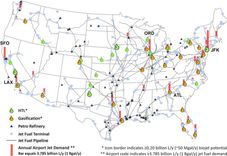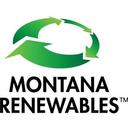DOE: Optimizing a waste-to-fuel future for aviation



Researchers show that the United States produces enough waste to create an economically viable amount of sustainable aviation fuel. Image from The Pixelman | Pixabay.
October 3, 2024
BY Karthikeyan K. Ramasamy, Laboratory Relationship Manager, Pacific Northwest National
The U.S. aviation sector, responsible for around 2% of the nation’s annual carbon emissions, is a key target for decarbonization—but there are many technical and logistical hurdles remaining when conceptualizing an efficient, scaled future for the production and use of sustainable aviation fuels (SAF).
Waste-to-fuel is one of the most promising pathways for SAF, turning the organic molecules in household garbage, sludge from water treatment plants, and plant detritus from farming, into biocrude oil that can be refined for use in aviation and other applications. With waste-to-fuel SAF becoming an increasingly viable technology, researchers at Pacific Northwest National Laboratory (PNNL) are exploring ways to optimize infrastructure and siting decisions for producing, transporting, storing, and using those fuels in the U.S.
Advertisement
Advertisement
In a recent U.S. Department of Energy (DOE) Bioenergy Technologies Office funded study, Cost-Effective Opportunities to Produce Sustainable Aviation Fuel from Low-Cost Wastes in the U.S, PNNL researchers identified the most efficient sites for waste-to-fuel SAF production facilities. The optimum solution is co-locating the SAF production facilities with the places where significant amounts of waste is produced and airports where SAF could be used at high volumes.
The researchers focused on wet waste (sludge, manure, etc.) and dry waste (food scraps, paper, yard waste, etc.), both of which tend to scale in volume with nearby population. The major airports near these population centers, in turn, tend to consume enormous amounts of jet fuel—the top five airports in the country all use more than a billion gallons of jet fuel every year.
The benefit of producing SAF nearby varies by site. For example, a SAF production facility in Los Angeles, which produces less usable waste, could replace 7% of the jet fuel used at Los Angeles International Airport (LAX); Chicago’s O’Hare International Airport, meanwhile, uses less fuel than LAX but has more available waste, meaning that a co-located production facility could replace 22% of that airport's annual jet fuel with SAF. The co-location of SAF production with SAF use could potentially reduce both the costs and the impacts associated with transporting fuel to its point of use.
Advertisement
Advertisement
The study found that with 100 or fewer waste-based SAF refineries located at or near airports, the U.S. could replace 15-25% of its annual jet fuel supply. However, there are still significant hurdles in scaling waste-to-fuel SAF: work remains to make SAF cost-competitive with traditional fuels, for instance, and there is a limited amount of usable waste. Researchers are also cognizant of the need to minimize the refineries’ impacts on the surrounding communities. But moving toward these technologies would be a major step toward a more sustainable future for aviation—and a major step away from landfills.
Learn more about siting for waste-to-fuel SAF production in PNNL’s study, published in ACS Sustainable Chemistry & Engineering.
Related Stories
MOL Group has produced a diesel fuel containing hydrotreated vegetable oil (HVO), and sustainable aviation fuel (SAF) at the refinery of Slovnaft in Bratislava. The quality of the products has been verified by radioisotope analysis.
OMV Petrom has announced the start of construction for a sustainable aviation fuel (SAF) and renewable diesel (HVO) production unit at the Petrobrazi refinery in Romania. The new facility will have an annual capacity of 250,000 tons.
CVR pauses development of potential SAF projects pending regulatory, tax credit clarity
CVR Energy Inc. released fourth quarter financial results on Feb. 18, reporting reduced renewable diesel production. The company also said it is pausing development of SAF capacity pending clarity on government subsidies.
Calumet Inc. on Feb. 18 announced that its subsidiary Montana Renewables LLC has received the first drawdown of approximately $782 million from its $1.44 billion U.S. DOE loan guarantee. The loan will fund the expansion of SAF production capacity.
Neste Corp. on Feb. 13 released fourth quarter financial results, reporting that its renewables segment was impacted by both market and operational challenges during the three-month period. Sustainable aviation fuel (SAF) sales, however, were up.
Upcoming Events










